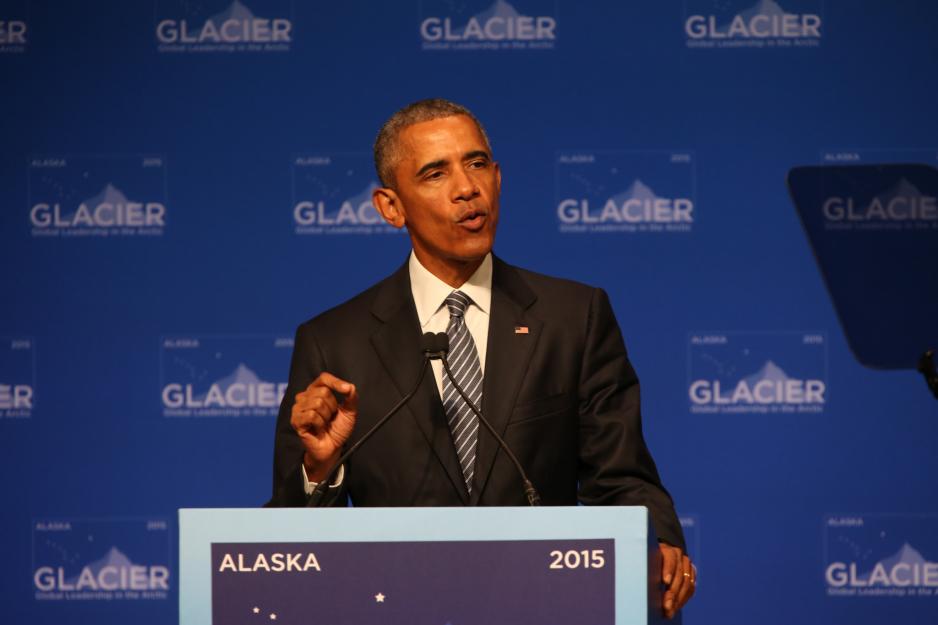Commentary: A Blueprint for Global Climate Action to Avert an Arctic Meltdown

Buried beneath last week's headlines is the fact that the world made critical progress in the fight against global climate change. After a months-long push by President Obama, Secretary of State John Kerry, and U.N. Secretary General Ban Ki-moon, the number of countries that have officially joined the Paris Agreement—a global pact to curb greenhouse gas pollution–hit 60.
Together, these countries represent 48 percent of global greenhouse gas pollution. Under the legal structure of the Paris Agreement, the pact won't take effect until its ratifying parties account for 55 percent of global emissions. That threshold, however, is now in clear reach: Countries representing another 12 percent of global emissions are expected to submit their Paris ratification papers by the end of this year.
In his last address to the U.N. General Assembly as President of the United States, President Obama on September 20 urged world leaders to move immediately to transition to a low-carbon global economy and minimize the toll that climate change could take on people and their livelihoods for generations to come. The president warned that without bold moves to reduce climate change threats, "the bill that could come due will be mass migrations, and cities submerged and nations displaced." The next day, President Obama set a noble example, issuing a Presidential Memorandum calling on U.S. federal agencies to take a "comprehensive approach" to identify and reduce the know security risks current of climate change at home and abroad, and those anticipated in the coming decades.
Still, while prospects for reducing the risks of climate change now look a bit rosier, the future ability of our planet to sustain life as we know it remains highly questionable. More ambitious global actions are needed to both rein in global greenhouse gas pollution and identify and manage the threats of climate change to people around the world.
President Obama has another shot at advancing new actions to avoid the worst climate change effects. Armed with new evidence of accelerating Arctic warming and approaching environmental tipping points, the Obama administration will convene science ministers from 24 countries on September 28. The goal of this first-ever White House Arctic Science summit is to assess the rate and consequences of Arctic climate change and weigh global strategies for averting its worst effects.
The Arctic is warming twice as fast as the rest of the planet, setting off an avalanche of dangerous changes at the top of the world—including vanishing Arctic snow and ice, thawing permafrost, and melting of the Greenland ice sheet. These changes risk triggering irreversible tipping points and likely will carry perilous side effects, such as unmanageable sea-level rise and coastal flooding, more frequent extreme weather, and increased warming and carbon emissions.
Fortunately, a small window of time remains to prevent catastrophic Arctic and global warming. The science ministers gathering at the White House Arctic Science summit have a chance to initiate new actions that would help world leaders better understand and avoid crossing dangerous Arctic warming thresholds.
As described in a recent report by the Center for American Progress, Avoiding a Full Arctic Meltdown: A Blueprint for Near-Term Global Action, Arctic Science ministers should launch a high-level panel of leading policy and science experts to identify the timing, triggers, and consequences of Arctic and global climate thresholds. This panel would also identify monitoring gaps that must be filled to track and project changes to critical Arctic systems—including sea ice, permafrost, and ice sheets—and to better understand Arctic-warming thresholds. The panel would then present key findings to world leaders ahead of the 2018 "facilitative dialogue" designed to "take stock of collective efforts of Parties" to meet the Paris Agreement goals. With cutting-edge data on dangerous warming thresholds in hand, country leaders would then be equipped to put forward by 2020 new or updated national climate goals that would help the world avoid perilous levels of Arctic and global warming.
As it stands, the Intergovernmental Panel on Climate Change (IPCC), the body responsible for bringing climate science into the UNFCCC and Paris Agreement process, writes their consensus climate assessment reports every six to seven years. The three working group contributions to the IPCC's 6th Assessment Report are not due for release until 2020 and 2021, and the Synthesis Report will not be ready until 2022. The IPCC has agreed to draft a special report on the effects of climate change on oceans and the cryosphere—the icy parts of the Earth—but it is unclear when this report will be published. This timeline is too slow and uncertain to provide world leaders the crucial information leaders need to evaluate collective progress and set 2020 national goals that would steer the planet away from dangerous climate change tipping points.
At the White House Arctic Summit, science ministers must also shine a stark light on the latest Arctic science and make a compelling case for urgent global action to fight climate change. And the world must listen. Nations have several opportunities this fall to take new steps to combat global warming. For example, world leaders must create a strong market-based system to curb aviation emissions when they meet in Montreal for the 39th Assembly of the International Civil Aviation Organization from September 27 to October 7. Global aviation produces roughly 2 percent of global CO2 emissions today, but emissions from this sector are soaring and are expected to triple globally by 2050.
In addition, world leaders should reach agreement on an amendment to phase down dangerous and heat-trapping hydrofluorocarbons (HFCs) when they convene at the 28th Meeting of the Parties to the Montreal Protocol in Kigali, Rwanda from October 8 to 14. HFCs have replaced many ozone-depleting substances used for conditioning, refrigeration, foams, and aerosols, but they remain potent greenhouse gases and are accelerating global warming as their use rapidly rises.
Lastly, world leaders can lay the foundation for a strong and transparent accountability system to support the Paris Agreement's implementation when they meet in November in Marrakech, Morocco for the 22nd Conference of the Parties, or COP 22, under the UNFCCC. A rigorous accountability system is key to ensuring that countries meet their existing climate commitments and raise the ambition of those commitments every five years.
With the security, safety and well-being of people around the globe at stake, science ministers and world leaders cannot afford another lost opportunity. They must take these pragmatic and meaningful actions to prevent catastrophic Arctic and global warming.
This article originally appeared in The Huffington Post.

